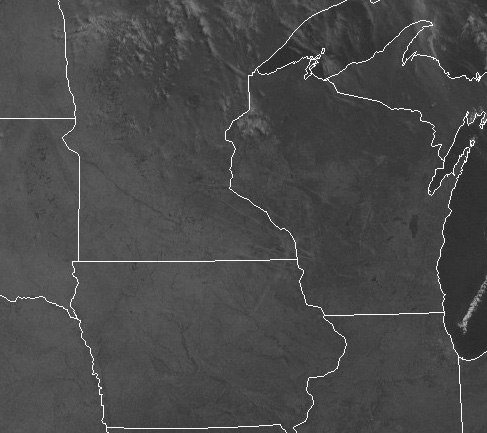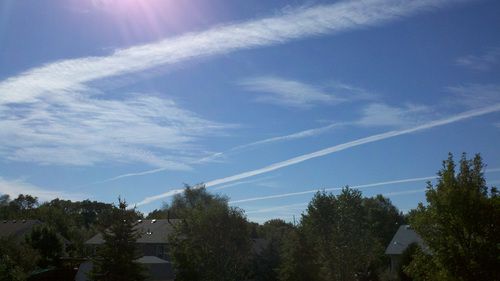For a short time today — too short to get a decent picture — the sky over Minnesota was wearing a pinstripe suit, thanks to the weather conditions that made obvious what is true all the time — there’s a highway over us.
Jet contrails only form to this degree in certain weather conditions.
Let’s turn it over to Dr. Steve Ackerman at the University of Wisconsin for a proper explanation:
If you are attentive to contrail formation and duration, you will notice that they can rapidly dissipate or spread horizontally into an extensive thin cirrus layer. How long a contrail remains intact, depends on the humidity structure and winds of the upper troposphere. If the atmosphere is near saturation, the contrail may exist for sometime. On the other hand, if the atmosphere is dry then as the contrail mixes with the environment it dissipates. Contrails are a concern in climate studies as increased jet aircraft traffic may result in an increase in cloud cover. It has been estimated that in certain heavy air-traffic corridors, cloud cover has increased by as much as 20%. An increase in cloud amount changes the region’s radiation balance. For example, solar energy reaching the surface may be reduced, resulting in surface cooling. They also reduce the terrestrial energy losses of the planet, resulting in a warming. Jet exhaust also plays a role in modifying the chemistry of the upper troposphere and lower stratosphere. NASA and the DOE are sponsoring a research program to study the impact contrails have on atmospheric chemistry, weather and climate.
Coincidentally, 11 years ago tomorrow provided some important data in the research of this question about whether contrails can influence the weather, the Christian Science Monitor reported…
Then Sept. 11, 2001 presented a unique opportunity to study what the sky looked like without airplanes and contrails. In the wake of the 9-11 terrorist attacks, the FAA prohibited commercial aviation over the United States for three days. That’s when David Travis, an atmospheric scientist at the University of Wisconsin, Whitewater, thought to look at how temperatures might differ at temperature stations around the country.
He found that [PDF], for those three days, the average range between highs and lows at more than 4,000 weather stations across the US was 1 degree C wider than normal. In other words, contrails seemed to raise nighttime temperatures and lower daytimes ones.
But the real effect was in daytime highs, which were much higher. That would seem to indicate that, contrary to prevailing thinking, contrails might have a net cooling effect.
Certain areas seemed particularly sensitive to the absence of contrails. Because of unique climatic conditions in the atmosphere in these regions — chiefly, moisture-laden air — the Pacific Northwest and the Midwest are often covered by contrails. But when planes stopped flying right after 9-11, Travis also found that these areas saw the most dramatic increase in daytime highs.
It’s unlikely much is being influenced, though, by today’s contrails. They’re evaporating fairly quickly, although several of them are faintly visible — especially in southeast Minnesota — in this satellite photo, taken around 10:15 this morning.


